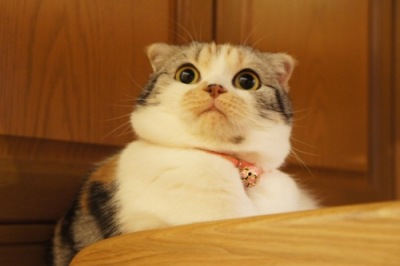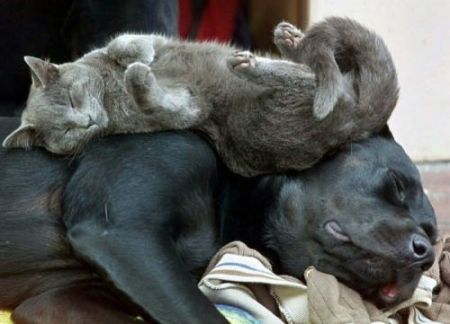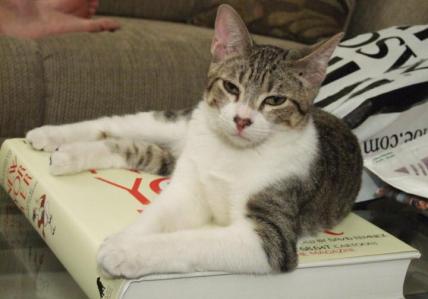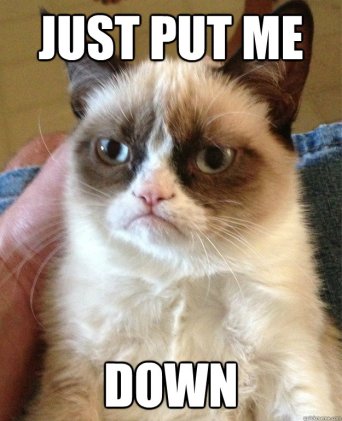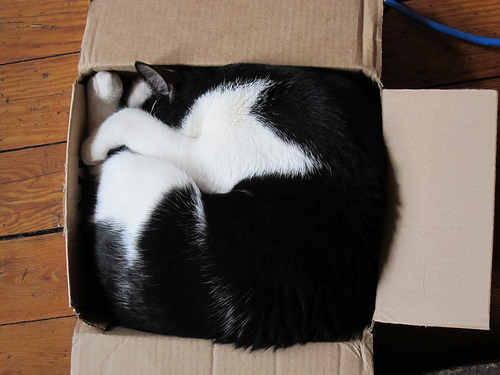You ever find yourself with some alone time—maybe you’re cleaning out a litter box, maybe you’re taking the cat for a walk—when your brain puts together the pieces of a puzzle you didn’t even know you were trying to solve? We all have those moments, and for many of us, one of them is when we realize that there is a dramatic difference between the practical uses of hyphens, en dashes, and em dashes.

Let’s be real. This is where 90% of those realizations happen.
For those of you who have yet to experience this heart-stopping, adrenaline-filled punctuation epiphany, this post may help you along in a more subtle, nurturing manner.
Our topic for this post comes from a new reader, who is definitely, completely, not in any joking manner named Duai Rilly Hafta:
My question, Grammar Cat, concerns the use of the em-dash.… My book is full of them because it seemed to reflect how I think, but I wonder if there are conventions for good usage versus, for example, the dry, uninteresting semi-colon.
All cheap jabs to the majestic semicolon aside, this is a great question.
Hyphen:
This is the smallest of the little horizontal line thingies that the English language uses. The most common use is to connect words for clarification. The function is basically the same as when people hold hands to let everyone know they’re together. It’s the “he’s with me” of the punctuation world.
The most common culprit of hyphen use is the phrasal adjective, which you probably already understand, even if you don’t know you know it. Let’s start simple. An adjective is something that describes a noun. A phrase is a group of words that may have a noun or a verb included, but no one is actually doing anything, meaning it’s not a complete sentence with a subject and verb.
The CMoS is kind enough to give a set of rules to follow for phrasal adjectives. Here they are, paraphrased and with cats.
1) If the phrasal adjective is placed before the noun it describes, hyphenate!
ex. That was a cat’s-out-of-the-bag moment.

“Your boyfriend got you a spatula for your birthday.”
2) If the phrasal adjective before the noun contains a compound noun, the compound noun must also be hyphenated.
Compound nouns are just nouns that require more than one word to describe them. For example, cat litter is a compound noun, because either word alone does not express the same idea as the two words combined.
I need to buy some cat. ←Sounds like you’re buying cat meat.
I need to buy some litter. ←Sounds like you’re making terrible financial decisions.
I need to buy some cat litter. ←Okay, I get it now.
So if one of those compound nouns shows up in a phrasal adjective that comes before the noun it describes, hyphenate it along with the rest of the phrasal adjective.
Ex. My cousin Gary is a cat-litter-scooping maniac.

“Is Gary gone yet?”
3) If more than one phrasal adjective is used to describe a noun, you better get your act together and hyphenate each one separate from each other.
Ex. Dude, I think I accidentally adopted a twelfth-regeneration time-lord cat.

NERD ALERT!
4) If two phrasal adjectives share a common ending element, then… Well, I’ll spare you the jargon. Just do it like this:
Ex. Both blue- and green-eyed cats are fully capable of stealing your heart.
But not:
Blue-and-green-eyed cats, because that refers to cats with one blue eye and one green eye.

“Look what your bad hyphenation has done to me! I’m a freak!”
However, if the shared element of the two phrasal adjectives is at the beginning, then you don’t get to use this convenience, and you have to write it twice.
Ex. Brown-eyed and brown-haired cats are the best.
5) If the phrasal adjective includes a duration or amount, the plurals should be changed to singular. So say your cat has been alive for four months. That would make it a four-month-old cat. This is probably the most common misuse of hyphens around. Here are the two correct ways to write age:
a) I own a ten-year-old cat. ←Notice that it’s hyphenated because it appears before the noun “cat,” which it modifies. Also notice that it’s year instead of years.
b) My cat is ten years old. ←Notice that it’s not hyphenated because the adjective appears after the noun it modifies. Also notice that the plural years is back.
6) Sometimes these hyphen rules look terrible once they’re employed. CMoS suggests that in such cases, you find a way to rework the sentence so it doesn’t look so sucky.
En dash:
The en dash is not interchangeable with the hyphen. Ever. Never, ever.
Here are some uses of the en dash:
1) To indicate a rage of numbers, be it time, distance, page numbers, etc.
Ex. I spent 3–4 hours working on this Grammar Cat post.
But if the word from precedes the range, the en dash will not work, and it must be replaced by the word to.
Ex. I worked on the Grammar Cat post from 2pm to 5pm.

Being a Grammar Cat is not all fun and games.
2) To signify to in the context of scores or directions.
Ex. The Carolina Panthers beat the Jacksonville Jaguars 35–17.
Ex. The Austin–Houston commute should be avoided at all costs.

…unless you have this sweet ride.
3) To indicate stuttered syllables in dialogue. Do keep in mind, though, that making a reader trudge through too much stuttering isn’t going to win you any fans as an author.
Ex. “I just w–w–wanted to p–pet the kitty,” the child said through his tears.
Em dash:
Before we get into the em dash and how it can basically be used for most other punctuation marks, let’s have a heart-to-heart conversation about moderation. Em dashes, like exclamation points, can be overused simply because they are so versatile. However, they’re also a fairly loud punctuation mark (like the exclamation point), and draw quite a bit of attention to the element they set off from the rest of the text. So imagine you have a friend who is totally into everything. Your friend is always touting the hottest new band who he loves so much. Do you go and listen to every band his says is the next best thing? Probably not. But if you have a friend who is rarely opinionated but implores you to check out this awesome band he heard, you’re likely to listen. Analogy complete.
1) Okay. The em dash, sometimes simply called “the dash,” can be used to replace parentheses, comma pairs, or a colon.
Here’s a sentence that uses a colon:
Alice in Wonderland provides us with one of the freakiest animal characters known to man: the Cheshire cat.
Now here it is with an em dash:
Alice in Wonderland provides us with one of the freakiest animal characters known to man—the Cheshire cat.

Totally not 100% nightmarish.
Both are correct; however, the colon is a little sharper of a punctuation mark than the casual em dash in this case. The colon is a jab, while the em dash is a nudge.
Here’s a sentence that uses a comma pair (meaning the commas are used to set off non-essential information):
The litterbox, the place where my cat spends most of his time, is starting to stink up the house.
Now with em dashes:
The litterbox—the place where my cat spends most of his time—is starting to stink up the house.
In these two examples, the commas are much more discreet than the em dashes and the separate ideas flow more smoothly.
Here’s a sentence that uses parentheses:
The kitten (he was really more of a cat at this point) no longer fit into his sweater.
Now with em dashes:
The kitten—he was really more of a cat at this point—no longer fit into his sweater.

“I think it shrunk, is all.”
So how does one choose between parentheses and em dashes? Consider parentheses are more of a whispered side note than the loud em dash.
2) The em dash can separate an introductory noun or series of nouns from the pronoun that describes it. Right? I wouldn’t be able to process that without an example, either, so here you go:
Ex. Hoping for catnip, naps, and staring into space—those are the three major pastimes of cats.
3) The em dash can be used to indicate a sudden interruption to thoughts or dialogue. This is not to be confused with ellipses, which indicate a trailing off of thought or speech. The em dash is much more sudden.
Ex. “Meow, meow, meow, me—”
“Shut up, Fluffy!”
4) When dialogue is interrupted in the middle of a sentence by narration that does not include some sort of dialogue tag (he said, she yelled, etc.), use pair of em dashes to insert the narration.
Ex. “I wish I’d written The Cat in the Hat, because”—he puffed up his chest—“I could have added more violence.”
***Note*** Question marks and exclamation points can come before an em dash, but commas, colons, semicolons, and periods (with rare exceptions you may live your whole life without encountering) cannot.
♥ ♥ ♥
Along with the topic request, Duai Rilly Hafta writes, My other question is whether Claire has Italian aunts at all.
This is, of course, in reference to a previous post, which can be seen here. The answer is that yes, Duai, all of my aunts are fairly Italian, but they are not, in fact, named Maria. However, were I to tell you their real names, I would likely incur the wrath of a handful of fairly Italian aunts, which any fairly Italian niece knows is not a smart fight to pick.

“I will have my revenge in this life or the next.”
